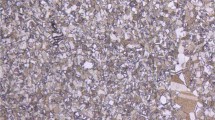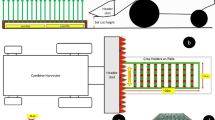Abstract
The amount of energy required to harvest Napier grass and the quality of the cut depend on the blade angles. Hence, it is crucial to analyses the impact of different cutting blade angles, including the bevel angle, shear angle, and approach angle, on both the specific cutting energy (SCE) and cutting index (CI) of Napier grass. Therefore, to achieve minimum specific cutting energy (SCE) and cutting index (CI), the optimization of blade angles was carried out. The study employed a pendulum-type impact testing apparatus to investigate the impact of operational parameters of the cutting blade on the SCE and CI for Napier grass. In addition, the current study utilized the response surface method for analysis and optimization purposes. The optimum operational parameters were found to be bevel angle of 15°, shear angle of 20.74°, and approach angle of 30°, which predict the minimum SCE of 19.84 kJ m−2 and CI of 1.89. The performance of the pendulum testing machine was validated by setting optimum conditions. It was found that the SCE was 20.20 kJ m−2 along with CI of 2. This result shows that the validated results are closer to predicted result. In future research, it is crucial to evaluate the cutting element’s performance in the Napier grass harvester under the aforementioned conditions. Additionally, a thorough investigation into the influence of the cutter’s peripheral velocity and the prime mover’s forward speed on the SCE requirements of grass is essential.





Similar content being viewed by others
References
S.S. Kadam, A. Kumar, M. Arif, Int. J. Curr. Microbiol. App. Sci. 6, 4778 (2017)
N.R. Sarker, M.A. Habib, D. Yeasmin, F. Tabassum, R.A. Mohammed, Am. J. Plant Sci. 12, 914 (2021)
I. Mohammed, Y. Abakr, F. Kazi, S. Yusup, I. Alshareef, S. Chin, Energies 8, 3403 (2015)
D. Takara, S.K. Khanal, Bioresour. Technol. 188, 103 (2015)
A. Kumar, B. Sahoo, A.K. Panda, S. Tanuja, D.A Shivaji, P. Samal, S.K. Nayak, D.N. Sadangi, ICAR - Central Institute for Women in Agriculture, Bhubaneswar, Odisha, accessed on December (2023)
D. Desrial, Ridha, IOP Conference series: earth and environmental science 542, 012035 (2020).
M. Qiu, Y. Meng, Y. Li, X. Shen, Biosys. Eng. 206, 135 (2021)
B. Jyoti, K. Karthirvel, Agricultural Mechanization in Asia, Africa and Latin America, 52, 15 (2021)
S. Ma, P.A. Scharf, Q. Zhang, M. Karkee, J. Tong, L. Yu, Trans. ASABE 59, 813 (2016)
C.-C. Lien, H.-W. Liu, Appl. Eng. Agric. 31, 5 (2015)
S. Kroes, H. Harris, EurAgEng (1996)
R.V. Powar, V.V. Aware, P.U. Shahare, J. Food Sci. Technol. 56, 3481 (2019)
R. Powar, V. Aware, P. Shahare, J. Food Sci. Technol. 56, 3272 (2019)
R. Abatabae, G. Kiani, Pak. J. Biol. Sci. 1, 1532 (2007)
O. Ghahraei, M.H. Khoshtaghaza, B. Ahmad, J Centr. Europ. Agric. 9, 7 (2008)
R. Powar, V. Aware, P. Chavan, A.K. Jaiswal, J. Food Process Eng 46(10), e14146 (2022)
R.V. Powar, V.V. Aware, A.A. Deogirikar, S. B. Patil, in Transforming coastal zone for sustainable food and income security. ed. by T.D. Lama, D. Burman, U.K. Mandal, S.K. Sarangi, H.S. Sen (Springer International Publishing, Cham, 2022), pp.1071–1083
Acknowledgements
The corresponding author acknowledges the Dr. D. Y. Patil College of Agricultural Engineering and Technology, Talsande, India, for encouraging and supporting for this study.
Funding
The author(s) received no financial support for the research and publication of this article.
Author information
Authors and Affiliations
Corresponding author
Ethics declarations
Conflict of interest
The authors declare that they have no conflicts of interest.
Additional information
Publisher's Note
Springer Nature remains neutral with regard to jurisdictional claims in published maps and institutional affiliations.
Rights and permissions
Springer Nature or its licensor (e.g. a society or other partner) holds exclusive rights to this article under a publishing agreement with the author(s) or other rightsholder(s); author self-archiving of the accepted manuscript version of this article is solely governed by the terms of such publishing agreement and applicable law.
About this article
Cite this article
Powar, R.V., Belanekar, N.N., Chamakale, S.V. et al. Modeling and Optimization of Specific Cutting Energy Required for Cutting Napier Grass Using RSM. J. Inst. Eng. India Ser. A 105, 167–175 (2024). https://doi.org/10.1007/s40030-024-00780-x
Received:
Accepted:
Published:
Issue Date:
DOI: https://doi.org/10.1007/s40030-024-00780-x




